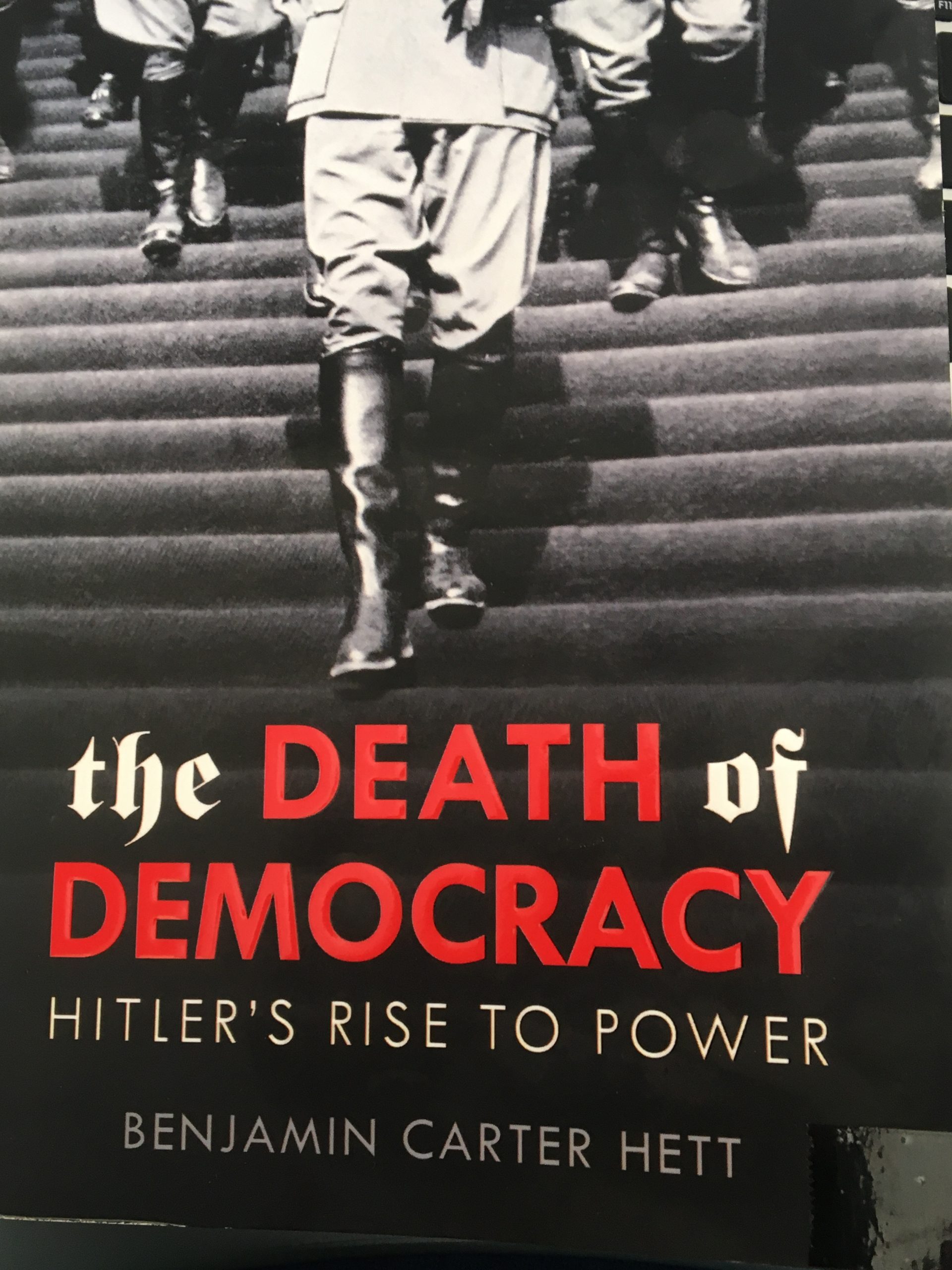This well-argued book is a warning from history. Anyone who wants to understand how the Nazis came to power and how much democracy depends on commitment to making the system work should read it. Historian Benjamin Carter Hett shows the similarities between the diabolical political situation in Germany in the early 1930s and that of western democracies.

He prosecutes a compelling argument about the reasons for the rise of the despicable, despotic and disastrous Nazi regime. By 1930, there was mass disillusionment with the political system, a big proportion of the population economically struggled and the lies continually told by a major party leader, Adolf Hitler, were part of his political toolkit. Sounds familiar.
Hitler explained in his book, Mein Kampf, why he lied: “ … the broad masses of a nation are always more easily corrupted in the deeper strata of their emotional nature than consciously or voluntarily; and thus in the primitive simplicity of their minds they more readily fall victims to the big lie than the small lie, since they themselves often tell small lies in little matters but would be ashamed to resort to large-scale falsehoods.”
One of the most widely-known and influential thinkers on management, Peter Drucker (1909-2005), lived in Germany is the early 1930s. He later recalled an anecdote for the role the disregard for the truth and rationality played in the rise of Nazism: “… many years ago I heard a Nazi agitator proclaim to a wildly cheering peasants’ meeting: ‘We don’t want lower bread prices, we don’t want higher bread higher prices, we don’t want unchanged bread prices – we want National Socialist bread prices.’ ” Higher, lower and unchanged bread prices had all failed. “The only hope lies in a kind of bread price which is none of these, which nobody has ever seen before, and which belies the evidence of one’s reason.” This reasoning makes as much sense as a flat earth, people not causing the climate catastrophe and vaccination causing autism.
Hett debunks the conventional wisdom that the rise of Nazism was:
1. A product of the Wall Street Crash that precipitated the Great Depression
2. The unreasonable terms of the Versailles Treaty – especially the onerous financial repatriations
3. The instability of the Weimar Republic.
Hett argues the bull market on Wall Street in 1928 – and not the Crash the next year – that caused the hard-hitting Depression in Germany. The country depended heavily on foreign loans, many of which were short-term, to make its reparation payments. The bull market attracted capital from throughout the world which left Germany short. It was part of a perfect storm of unrelated financial factors that culminated in the late 1920s. A worldwide fall in food prices fuelled protests in Germany’s rural areas. The rise of automation at the cost of labour increased unemployment. In just one industry, mining, the workforce in the industrial Ruhr region dropped by 33% between 1922 and 1928. Unemployment in Germany was already 1.3 million by mid-1928.
Right-wing political parties made much about the injustice inflicted on Germany by the Versailles agreement. “A persistent myth has it that the (agreement) was excessively harsh, and that its harshness explains the rage that gave rise to the Nazis. Actually, the treaty was the mildest of the post-First World War settlements . . . Certainly, almost all Germans perceived the treaty to be unjust, which didn’t necessarily make it so.”
That notwithstanding, the Allies wanted to manage Germany’s financial position as “financial arrangements in interwar Europe were really about security and, in particular, keeping Germany in line. So long as reparations and the gold standard constrained Germany, it could not threaten its neighbours.” Germany successfully negotiated reductions and postponements.
By any measure, the republic was politically unstable. There were 13 chancellors and 21 different administrations in just over 14 years. And the President, Paul von Hindenburg, and none of the political parties – except the Social Democrats – supported the Republic. But there wasn’t big movement in voter support. Hett categorises voters into “camps” or “confessionals”, a religious term for shared values and beliefs. There were three confessionals:
1. Socialists (Social Democrats, Communists)
2. Catholics (Centre Party, Bavarian People’s Party)
3. Protestants (German Nationals, German Democratic Party, German People’s Party, Nazis).
Individual parties’ voter support fluctuated but it was only after 1933 that the Nazis broke out of the Protestant middle-class camp and won more than 30% of the vote. Much of that support was in non-metropolitan areas. The city/country divide was as stark in Germany in the early 1930s as it is in the UK and USA today.
Another contributing factor for the Nazi rise was the vain Hindenburg, the incompetent and vacuous Franz von Papen and the scheming, devious General Kurt Schleicher. This trio wanted a right-wing dictatorship they would control. They got the dictatorship but not the control.
Despite the overwhelming odds against the republic’s survival, two men worked assiduously to maintain it and peace in Europe. Gustav Stresemann, Germany’s Chancellor in 1923 and Minister for Foreign Affairs from 1923 to 1929, and Astride Briand – French prime minister several times and Minister for Foreign Affairs from 1925 to 1932. They talked about bringing their respective countries closer economically. They were the trail blazers of the European Union. Similar forces that fuelled the Nazi rise to power today threaten the EU and democracy in many countries.